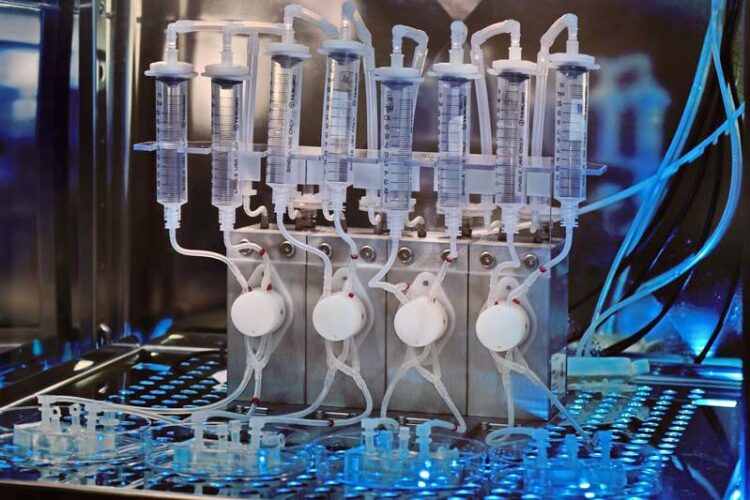Process Chains for Isolation and Analysis

Parallel, continuous perfusion of four organ-on-chip systems.
Credit: Fraunhofer ILT, Aachen, Germany
… from Single Cells to Organoids.
Researchers at the Fraunhofer Institute for Laser Technology ILT are working on new tools for the preparation and analysis of single cells and cell assemblies. The team developed the “Liftoscope”, a system for cell sorting for subsequent cultivation that can analyze and transfer biomaterials precisely and in a way that is gentle on cells. In addition to this system, further 3D bioprinting methods are increasingly finding their way into biotechnological research: Thanks to the development of microfluidic organ-on-a-chip systems, various cells can be arranged in a defined and reproducible manner to form artificial tissues.
Future-oriented, biotechnological solutions and innovative laboratory technology await the approximately 35,000 visitors at analytica, with more than 700 exhibitors, the world’s leading trade fair for laboratory technology, analytics and biotechnology. In the first edition since the beginning of the corona pandemic, Fraunhofer ILT experts will be present and exhibit several topics relevant to the future of medical technology at analytica in Munich from June 21 – 24.
Analyze, isolate, transfer

Credit: Fraunhofer ILT, Aachen, Germany
To produce cell cultures, a laboratory must follow many different steps in which the cells are grown and examined. Indeed, cell cultivation is very time-consuming and error-prone owing to the manual work involved in conventional processes. At analytica, Fraunhofer ILT is presenting two projects on cell cultivation: In the joint project “Liftoscope”, Fraunhofer ILT is working with the Fraunhofer Institute for Production Technology IPT to develop a gentle, automated process for analyzing and isolating cells.
To accomplish this, the institutes use a high-speed microscope to scan a cell culture plate. Based on the image data, the cell morphology of the detected cells can be determined using a specially developed algorithm. To ensure that only suitable cell material is subsequently isolated, the researchers use laser-induced forward transfer, or LIFT for short: The cell cultures are located on the cell culture plate in a special hydrogel. A laser is focused into the gel very locally under the selected cells and generates a precisely tuned amount of thermal energy. The short pulse causes the gel to expand and transfer the cells to a cell culture support above, on which they are then further cultured.
The fully automated analysis and isolation process can be easily integrated into any laboratory environment. Thanks to its modular design, it is versatile and can be used in existing microscopes. A commercially available microtiter plate, for example, is suitable as a cell carrier. This makes the process not only time-saving, but also cost-effective.
Another challenge is the transfer of adherently growing cells: “Here we are still looking for the appropriate hydrogel to improve the survival rate of the cells,” says Richard Lensing, scientist in the Biofabrication Group at Fraunhofer ILT. To make the process even more efficient, researchers at Fraunhofer IPT and ILT are also working on a faster and more sophisticated algorithm that can classify and select cells based on various characteristics.
Organ-on-a-Chip
3D printing also provides the researchers with new opportunities: Bioprinting makes it possible to construct artificial tissues, helps society do without animal testing and im-proves therapy diagnostics. Fraunhofer ILT scientists will show several microfluidic organ-on-a-chip systems the size of a USB stick at analytica.
The aim of 3D bioprinting is to arrange cells in precisely defined and reproducible spatial configurations to form artificial tissues. Cell-laden hydrogels, so-called bioinks, are printed in an extrusion-based process. In such cultures, the cells develop approximately as they do in the body. At the same time, researchers can more easily intervene and observe the process. In combination with a microfluidic chip design, an organ-on-a-chip can be constructed from multiple cell types, which allow for easy analysis of cells. The tests can be precisely targeted and are expected to offer better and more accurate results when the effects of bacteria, viruses and drugs on in vitro tissues are studied.
You can talk to the experts from Aachen at the joint Fraunhofer booth 227 in hall A3 at analytica.
Wissenschaftliche Ansprechpartner:
Dr. rer. nat. Nadine Nottrodt
Biofabrication Group
Telephone +49 241 8906-605
nadine.nottrodt@ilt.fraunhofer.de
Dr. rer. nat. Elke Bremus-Köbberling
Biofabrication Group
Telephone +49 241 8906-396
elke.bremus@ilt.fraunhofer.de
Richard Lensing M. Sc.
Biofabrication Group
Telephone +49 241 8906-8336
richard.lensing@ilt.fraunhofer.de
Fraunhofer Institute for Laser Technology ILT
Steinbachstraße 15
52074 Aachen
Germany
www.ilt.fraunhofer.de
Weitere Informationen:
https://www.ilt.fraunhofer.de/en.html
https://www.ilt.fraunhofer.de/en/technology-focus/medical-technology/biofabricat…
https://www.ilt.fraunhofer.de/en/fairs-and-events/fairs/2022/analytica-2022.html
Media Contact
All latest news from the category: Medical Engineering
The development of medical equipment, products and technical procedures is characterized by high research and development costs in a variety of fields related to the study of human medicine.
innovations-report provides informative and stimulating reports and articles on topics ranging from imaging processes, cell and tissue techniques, optical techniques, implants, orthopedic aids, clinical and medical office equipment, dialysis systems and x-ray/radiation monitoring devices to endoscopy, ultrasound, surgical techniques, and dental materials.
Newest articles

Innovative 3D printed scaffolds offer new hope for bone healing
Researchers at the Institute for Bioengineering of Catalonia have developed novel 3D printed PLA-CaP scaffolds that promote blood vessel formation, ensuring better healing and regeneration of bone tissue. Bone is…

The surprising role of gut infection in Alzheimer’s disease
ASU- and Banner Alzheimer’s Institute-led study implicates link between a common virus and the disease, which travels from the gut to the brain and may be a target for antiviral…

Molecular gardening: New enzymes discovered for protein modification pruning
How deubiquitinases USP53 and USP54 cleave long polyubiquitin chains and how the former is linked to liver disease in children. Deubiquitinases (DUBs) are enzymes used by cells to trim protein…



